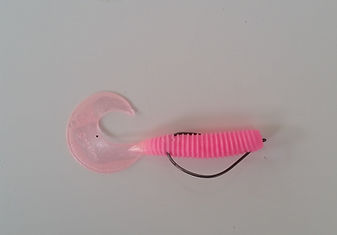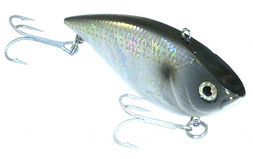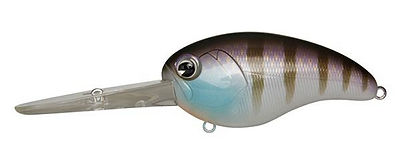

LURING
Many anglers in Singapore use lures at both pay ponds and reservoirs. In Singapore, there are laws against baiting at reservoirs so many anglers take up luring so that they can fish at reservoirs effectively. Luring is the only legal way to fish at reservoirs effectively but be prepared to spend a decent amount of money on lures.
When to use what lure
In every situation, there is no one best lure and the angler must choose which lure to use depending on the factors below:
1. Target fish
2. Feeding habit of fish
Below are description of what the factors mean:
1. Target fish
Most lures are made to target fish at a specific section of the water column. Generally, there are 3 columns - Surface, Midwater and Bottom. To catch fishes that roam the surface column, floating lures are generally used. To catch fishes that swim at the bottom, sinking lures are used to reach the bottom.

The DUO Realis Pencil is a walk-the-dog lure that moves about on the surface, perfect for surface feeders like snakeheads.

The ima Koume is a sinking vibe that can be used to target fish at the bottom.
2. Feeding habit of fish
Fishes may only take a specific size or colours of lure. Therefore, every lurer should have different kinds and sizes of lures and each kind of lure must have a few colour variety. Colour rotation is important when luring at pay ponds. These fishes are generally smarter and once they identify a specific colour or type of lure that they get caught on, they will not take that kind of lures.
Colour Rotation
You have 3 colours of a soft plastic - White, Pink and Orange. You start fishing with the White lures, after you catch some fish, the fish refuse to take the White lures as they have become wary of it. So switch to either the Pink or Orange lures to get fish.
Kind of lure
You have 2 kinds of lures - soft plastics and vibes. You start fishing with the soft plastics and you constantly get bites. However, after some time, the fish refuse to take your soft plastics. So switch to the vibes to catch more fish.
Lure Profile (Size of lure)
You have 2 sizes of the same kind of lure - 1.5 inch and 3 inch lure. You start with the 3 inch lure but you realise that the fish refuse to take this size of lure today. So switch to the 1.5 inch lure so that you have a chance of getting hits.
In short, your lure tackle box should contain different kinds of lures of different colours and sizes. This will maximise your catch rate at highly pressured fishing areas.
Tip: If you are targeting fish at the bottom, use brighter colours such as pink to attract them. Bright colours stand out very well in murky waters.



Colour rotation is a must when luring to get more fish.
Soft plastic lures, one of the many lure types.
A 1.5 inch lure.
Types of lures
There are many kinds of lures in the market and each lure has a different swimming action in the water. Some of these lures sink while some float. As said earlier, you should have different kind of lures in your tackle box to have the maximum chance of getting a hookup.
In Singapore, there are quite a number of lures in the market as luring is quite popular here. Below are some lures that are most effective in Singapore's waters:
1. Soft plastics
2 Vibes
3. Crankbaits
1. Soft plastics
Soft plastics are extremely versatile lures that can catch just about any fish. They also can be rigged in different ways to suit different terrains and cover different water depths. In Singapore, the more common shapes are the ones that are meant to mimic live fish. The difference in every soft plastic is the tail. Different tails have different swimming actions. In Singapore, the 2 most common tail shapes are paddletail and grubtail.

Paddle-tailed swimbait.

Grub-tailed swimbait.
How to fish them
Soft plastics are generally rigged on either a jighead or a worm hook, also known as a weedless hook. A jighead is basically a sinker with a hook attached while a worm hook is a hook with a shape that can nicely fit into a soft plastic.
When to use what
Jigheads are normally used at pay ponds where there are few snaggy areas. Worm hooks are normally used when fishing in snaggy waters because the hook point is not sticking out and the lure will not get stuck in plants of debris. It can actually be used in any scenario but at pay ponds, it is better to use a jighead as you will get more hookups compared to using a worm hook.

From top to bottom: Size 2/0 VMC Barbarian Jighead, Decoy Chinu Head Jighead for micro soft plastics and Gamakatsu worm hook
Lure presentation
It is easy to rig soft plastics wrongly as you are hooking on the soft plastic yourself as it does not come with the hooks. Lure presentation is very important as no fish will take a poorly rigged soft plastic. Lure presentation also ensure that your soft plastic swims the way it is supposed to.
Hooking soft plastics on worm hooks
Step 1: Position the worm hook next to the soft plastic to gauge where to start hooking the soft plastic
Step 2: Hook the soft plastic just out of the chin
Step 3: Push the hook through the hook slot and out of the back of the soft plastic and you will have a nicely rigged soft plastic.


Step 1
Step 2

Step 3
Hooking soft plastics on jigheads
Step 1: Position the jighead next to the soft plastic to gauge where to start hooking the soft plastic
Step 2: Push the hook throught the centre of the soft plastic and have the hook come out of the soft plastics and you will have a nicely rigged soft plastic.

Step 1

Step 2
Method of retrieve
1. Straight retrieve (Fast/Slow)
2. Lift and fall
3. Hopping at the bottom
2. Vibes
Vibes are lures that give off a vibration when retrieved in the water. If left to sink, the vibrations would flutter to attract fishes. These vibrations will get picked up by the fishes' lateral line and they will go over to investigate the source of vibration.

The Storm SX soft vib is a vibe that is very effective in local waters.

A husky vibe.

A hard plastic vibe.
Method of retrieve
1. Straight retrieve (Fast/Slow)
2. Lift and fall
3. Hopping
5. Crankbaits
Crankbaits are versatile lures that have a unique appearance. Crankbaits can be identified by a fat body and an oversized lip which allows it to dive. There are bottom and surface crankbaits in the market.

The ima Beasthunter is a deep-diving crankbait that can reach depths of around 4.2m.

A surface crankbait that centers on topwater fishing.
Method of retrieve
1. Straight retrieve (Fast/Slow)
2. Hopping
3. Twitching
Working your lures
Lures are not alive, every lure needs to be worked in different ways to make it seem like a living thing that the fish can bite on. If you do not work the lure correctly, then the fish will not even have a go at it.
1. Straight retrieve (Fast/Slow)
A straight retrieve is the easiest retrieve, just simply cast the lure out and crank the reel. If you are using a spinning reel, 1 full crank per second is considered a slow retrieve. For baitcast reels, the cranking speed should be slightly fast to achieve a slow retrieve as the spool of a baitcast reel is smaller. For fast retrieve, just increase the speed by a little. A slow retrieve will normally work better as it give time for the fish to see the lure and chase after it.
Used for: Vibes, crankbaits, soft plastics
2. Lift and fall
Lift and fall is another easy method. Simply cast the lure out and retrieve the line while lifting the rod up and down. This will make the lure look like a fish that is swimming up and down in the water.
Used for: Vibes, soft plastics
3. Hopping
Hopping is a method used to attract fish at the bottom. Cast the lure out, let it sink to the bottom and lift the rod up, then crank the reel and retrieve all the slack line. Wait for a while for the lure to sink to the bottom again and repeat. The lure will appear to go up and then sink back down. Vibes are useful when hopping as they have a fluttering action that can entice fish to bite.
Used for: Soft plastics, vibes, crankbaits
That's all for luring. Make sure you work the lures correctly and choose the right lures to get fish. Luring is hard to master but once you get the hang of it you will find that it is one of the most rewarding forms of fishing. If the fish are not biting, you may want to change the way you work your lure, the colour of your lure or the type of lure.
References:
Artofmanlinesscom. (2009). The Art of Manliness. Retrieved 18 August, 2016, from http://www.artofmanliness.com/2009/05/14/10-things-every-mans-fishing-tackle-box-needs/ In-text citation: (Artofmanlinesscom, 2009)
Takemefishingorg. (2016). Takemefishingorg. Retrieved 18 August, 2016, from https://www.takemefishing.org/how-to-fish/how-to-catch-fish/
In-text citation: (Takemefishingorg, 2016)